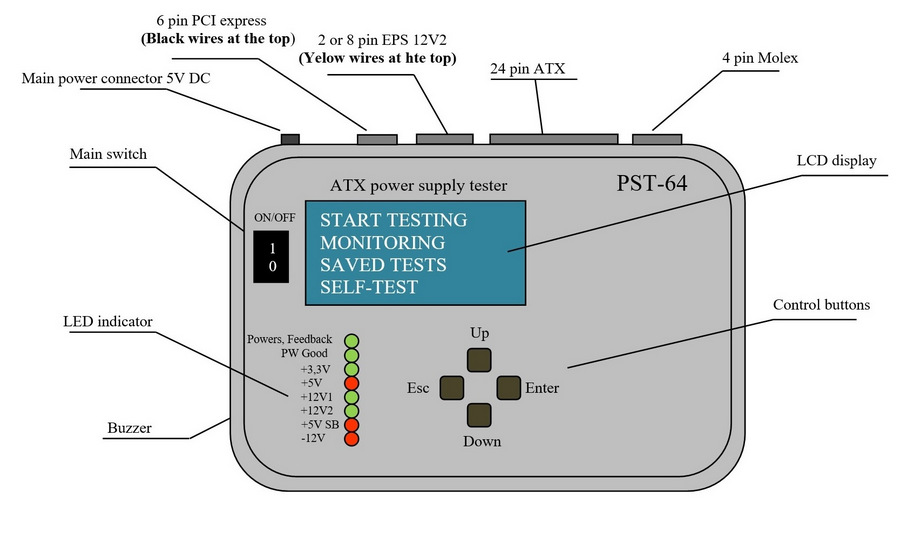Special ATX power supply tester PST-64

Description of the device
The PST-64 tester is intended for real, precise and professional testing of ATX power supplies. It provides an overview of all important qualities and values of the unit. PST-64 allows monitoring of voltage without loads in real time, monitoring of voltage fluctuation (Ripple), as well as noise (Noise), the latter an indicator of damaged filtration condensator or damage dealt to the electrical circuit of the power supply. Aside from the load monitoring function, the tester also contains a one-off test mode. In this mode, the device tests the source with resistor loads of a power output of up to 120W, allowing it to examine the source even more thoroughly. A very important indicator of the measured power supply’s condition is its calculated rough estimate of maximum output power. The results of such a test can be saved in the internal memory of the device. It is possible to store data records from four different measurements in the memory. The device also includes the „Self-test,“ function, in which the user can verify the functionality of the tester and its potential basic errors, which could cause imprecise measurements. The tester has a standard power input from the measured power supply. However, in the „Self-test“ mode, the tester needs to be connected to the power grid via an independent 230V AC,50Hz/5V DC power adapter, provided as a part of the set.
What is the PST-64 intended for?
The PST-64 tester serves for real, precise and professional testing of ATX power supplies. Its purpose is to detect the worsened condition of an ATX power supply sufficiently in advance, when it is necessary to replace such an unreliable unit, or repair it while the computer or server is still undergoing maintenance. Otherwise such a unit could fail during the computer’s full operation and cause substantial damages. Some computers in important operational facilities within businesses require a high degree of reliability, but that reliability is dependent to a great degree on the state of the power supply unit.
Why test ATX power supplies?
A quality power input source is the basic prerequisite for the reliable operation of every computer. A lowered quality of the power source can negativelly affect the correct working of an operation system, or even cause its complete disabling, as well as damage to the motherboard of the computer, along with other peripheral boards and the hard disk, which might contain data crucial to the user. To prevent such situations, it is necessary to preemptivenly diagnose the real state of an ATX power supply and dispose of the damaged unit adequately in advance.
Who is the tester intended for?
The tester is intended mainly for the employees of computer repair shops, server administrators, control centre and dispatching technicians, or everyone everywhere, where the bad technical state of a computer’s power supply can cause great damages and endanger the fluidity and security of operations. The tester is meant to serve for precautionary diagnostics and timely detection of unreliable sources, which could cause many problems during standard operations, when their reliable activity is necessary. Their primary goal therefore isn’t the detection of faulty or damaged sources in order to repair them, but the prevention of preventable failures in the computer systems of important operational facilities within businesses.
What can the PST-64 tester do?
PST-64 offers an overview of all important properties and quantities of the power supply. It allows the monitoring of voltages without loads in real time, the overseeing of voltage fluctuation (Ripple), as well as noise (Noise), the latter an indicator of damaged filtration capacitors or damage dealt to the electrical circuit of the power supply. Aside from the function of monitoring without load, the tester also includes a one-off test mode. In this mode, the device tests the source with resistor loads with a performance of up to 120W, with which it verifies the measured quantities and their shortcomings even more thoroughly. The results of such a test can be saved into the internal memory of the device. The memory can store saved records from up to four different measurements. The device also contains a „Self-test“ function, in which the user can verify the functionality of the tester and its potential basic errors, which could cause imprecise measurements. The standard power input for the tester is from the measured ATX power supply, but it is also possible to power it from an 230V AC/5V DC independent mains adapter, which is included in the set.
What does the tester consist of?
Main switch – for activating the device.
Power input connector – in case of power input through the adapter.
ATX output power connectors – for connecting the outputs of the measured power supply to the tester.
Display screen – displays detailed information about the measured values.
LED indicator – displays the basic states of the measured values of the individual outputs.
Control keys – for movement within the menu (Up, Down, Enter, Escape).
Buzzer – for the acoustic indication of the various states.
